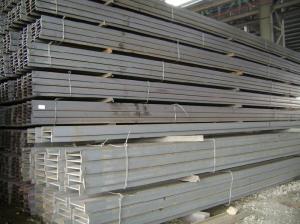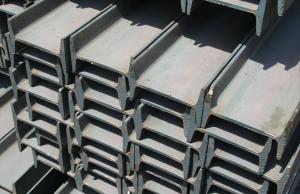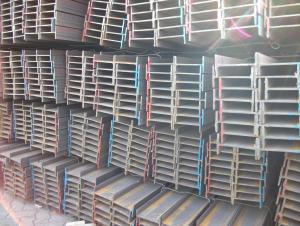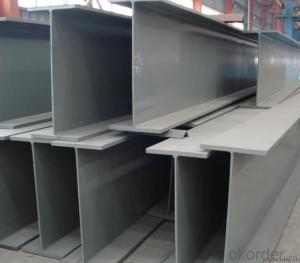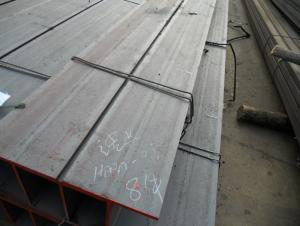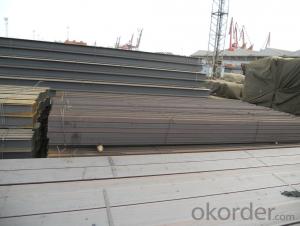I BEAM European Standard of IPE and IPEAA
- Loading Port:
- China Main Port
- Payment Terms:
- TT or LC
- Min Order Qty:
- 100 m.t.
- Supply Capability:
- 10000 m.t./month
OKorder Service Pledge
OKorder Financial Service
You Might Also Like
Product Description:
OKorder is offering I BEAM European Standard of IPE and IPEAA at great prices with worldwide shipping. Our supplier is a world-class manufacturer of steel, with our products utilized the world over. OKorder annually supplies products to African, South American and Asian markets. We provide quotations within 24 hours of receiving an inquiry and guarantee competitive prices.
Product Applications:
I BEAM European Standard of IPE and IPEAA are ideal for structural applications and are widely used in various building structures and engineering structures such as roof beams, bridges, transmission towers, hoisting machinery and transport machinery, ships, industrial furnaces, reaction tower, container frame and warehouse etc.
Product Advantages:
OKorder's I BEAM European Standard of IPE and IPEAA are durable, strong, and wide variety of sizes.
Main Product Features:
· Premium quality
· Prompt delivery & seaworthy packing (30 days after receiving deposit)
· Can be recycled and reused
· Mill test certification
· Professional Service
· Competitive pricing
Product Specifications:
Manufacture: Hot rolled
Grade: Q195 – 235
Certificates: ISO, SGS, BV, CIQ
Length: 6m-12m, as per customer request
Packaging: Export packing, nude packing, bundled
size | Kg/m |
IPE 100*55*4.1 | 8.1 |
IPEAA 100*55*3.6 | 6.72 |
IPE 120*64*4.4 | 10.4 |
IPEAA 120*64*3.8 | 8.36 |
IPE 140*73*4.7 | 12.9 |
IPEAA 140*73*3.8 | 10.05 |
IPE 160*82*5.0 | 15.8 |
IPEAA 160*82*4 | 12.31 |
IPE 200*100*5.6 | 22.4 |
IPEAA 200*100*4.5 | 17.95 |
FAQ:
Q1: Why buy Materials & Equipment from OKorder.com?
A1: All products offered byOKorder.com are carefully selected from China's most reliable manufacturing enterprises. Through its ISO certifications, OKorder.com adheres to the highest standards and a commitment to supply chain safety and customer satisfaction.
Q2: How many tons of steel products could be loaded in containers?
A2: Usually the steel products are delivered by bulk vessel because of the large quantity and the freight. However, there are no bulk vessel enter some seaports so that we have to deliver the cargo by containers. The 6m steel product can be loaded in 20FT container, but the quantity is changed according to the size, usually from 18tons to 25tons.
Q3: How soon can we receive the product after purchase?
A3: Within three days of placing an order, we will arrange production. The normal sizes with the normal grade can be produced within one month. The specific shipping date is dependent upon international and government factors, the delivery to international main port about 45-60days.
Images:
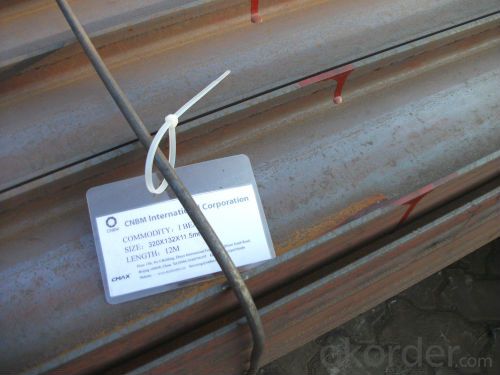

- Q:How do you calculate the moment of resistance for steel H-beams?
- One can calculate the moment of resistance for steel H-beams by utilizing the given formula: M = fy * Z. In this equation, M represents the moment of resistance, fy denotes the yield strength of the steel, and Z signifies the plastic section modulus of the H-beam. To ascertain the plastic section modulus, it is necessary to ascertain the extreme fiber distances from the neutral axis of the H-beam. These measurements can be obtained either from the manufacturer's specifications or by measuring the beam's dimensions. Once the extreme fiber distances have been determined, the plastic section modulus can be calculated using the subsequent formula: Z = (b1 * h1^2 / 6) + (b2 * h2^2 / 6) + (b3 * h3^2 / 6). In this equation, b1, b2, and b3 represent the widths of the various sections of the H-beam, while h1, h2, and h3 correspond to the heights of the different sections. After calculating the plastic section modulus, it can subsequently be multiplied by the yield strength of the steel to establish the moment of resistance. It is imperative to note that this calculation assumes that the steel H-beam behaves in an elastic-perfectly plastic manner and that the material does not exceed its yield strength.
- Q:How do steel H-beams perform in vibration-prone environments?
- Steel H-beams perform well in vibration-prone environments due to their high structural integrity and stiffness. The unique H-shape design offers excellent resistance against bending and torsional forces, minimizing the risk of structural failure or excessive vibrations. Additionally, steel beams have a high natural frequency, which helps absorb and dissipate vibrations, ensuring a stable and safe structure in such environments.
- Q:Can Steel H-Beams be used in museum or gallery construction?
- Yes, Steel H-Beams can be used in museum or gallery construction. Steel H-Beams are commonly used in construction due to their strength and durability. They provide structural support and can withstand heavy loads, making them suitable for large and open spaces like museums and galleries. Additionally, Steel H-Beams are versatile and can be fabricated to meet specific design requirements, allowing for unique architectural features. Their fire resistance properties also make them a safe choice for such buildings. Overall, Steel H-Beams are a popular choice in construction, including museum and gallery projects, due to their strength, versatility, and safety features.
- Q:Do steel H-beams require additional bracing?
- Yes, steel H-beams often require additional bracing. H-beams are structural beams that are used in construction to support heavy loads. While they are designed to be strong and durable, certain factors such as the length of the beam and the load it will bear may necessitate the use of additional bracing. Bracing helps to provide lateral support and prevent the beam from buckling or bending under the weight it is carrying. Depending on the specific requirements and design of the structure, bracing can be added to H-beams through various methods such as diagonal braces, cross braces, or struts. It is important to consult with a structural engineer or a professional in the field to determine the specific bracing needs for steel H-beams in a given construction project.
- Q:How do steel H-beams contribute to the overall structural integrity of a building?
- The overall structural integrity of a building is greatly enhanced by the presence of steel H-beams. These beams play a crucial role in providing support and stability by evenly distributing the weight and load of the structure throughout its framework. One of the primary advantages of steel H-beams is their capacity to withstand heavy loads and resist bending or warping when under pressure. The unique shape of the H-beam, featuring wider flanges and a narrower web, grants it greater strength and durability compared to other structural materials. As a result, it is well-suited for supporting large spans and heavy loads, such as those found in bridges, skyscrapers, and industrial buildings. Furthermore, steel H-beams possess exceptional tensile strength, enabling them to withstand forces that attempt to pull them apart. This characteristic is particularly beneficial in areas prone to natural disasters like earthquakes or strong winds, as it helps the building endure these external forces and prevents collapse. The versatility of steel H-beams also allows for flexibility in design and construction. They can be easily fabricated and shaped into various lengths and sizes, making them suitable for different architectural styles and structural requirements. This adaptability is especially important in modern construction, where architects and engineers strive for innovative designs while ensuring safety and stability. Moreover, steel H-beams have a long lifespan and require minimal maintenance. They exhibit high resistance to corrosion, which helps prevent deterioration over time. This durability ensures that the building's structural integrity remains intact for many years, reducing the need for expensive repairs or replacements. In conclusion, steel H-beams make a significant contribution to a building's overall structural integrity by providing strength, stability, and load-bearing capacity. Their ability to withstand heavy loads, resist bending, and possess excellent tensile strength guarantees the safety and longevity of the structure. Additionally, their versatility in design and long lifespan make them a preferred choice in modern construction.
- Q:Are steel H-beams vulnerable to termites or pests?
- No, steel H-beams are not vulnerable to termites or pests. Unlike wood, steel does not provide a food source for termites, and it is not susceptible to damage caused by pests. Steel H-beams are made from a strong and durable material that is resistant to infestations and can withstand various environmental conditions. Therefore, they are a reliable choice for structural support in buildings where termite or pest damage is a concern.
- Q:What is the cost of steel H-beams compared to other structural materials?
- When comparing the cost of steel H-beams to other structural materials, it is evident that steel offers a competitive price. The construction industry widely utilizes steel due to its strength, durability, and versatility. While the specific cost may vary depending on factors such as size, grade, and market conditions, steel H-beams generally present a cost-effective solution for structural needs. In contrast to materials like wood or concrete, steel H-beams exhibit superior strength and load-bearing capacity. This quality allows for longer spans and fewer supporting columns, resulting in cost savings in terms of materials, labor, and construction time. Moreover, steel possesses high resistance to environmental factors like moisture, fire, and pests, consequently reducing long-term maintenance costs. Despite the potential fluctuations in steel prices due to market conditions, it remains a favored choice for structural applications due to its availability and competitiveness. When considering the cost of steel H-beams, it is crucial to evaluate other factors such as project requirements, design considerations, and overall budget to determine the most suitable and cost-effective solution.
- Q:Can steel H-beams be used in high-rise buildings?
- Yes, steel H-beams can be used in high-rise buildings. Steel H-beams are commonly used as structural members in the construction industry due to their high strength and versatility. They are capable of withstanding heavy loads and are often used to support the weight of floors, walls, and roofs in high-rise buildings. The H shape of these beams provides a greater surface area for load distribution, making them an ideal choice for tall structures where the weight and pressure exerted on the beams are significant. Additionally, steel H-beams can be easily fabricated, allowing for efficient construction processes in high-rise buildings.
- Q:Can steel H-beams be used for agricultural structures?
- Yes, steel H-beams can be used for agricultural structures. Steel H-beams provide excellent structural support and can be used for various agricultural applications such as barns, warehouses, and equipment storage buildings. They offer high strength and durability, making them suitable for withstanding heavy loads and adverse weather conditions. Additionally, steel H-beams are versatile and can be easily customized to meet specific requirements, making them a popular choice for agricultural construction.
- Q:Can Steel H-Beams be used in mezzanine or raised platform construction?
- Yes, Steel H-Beams can be used in mezzanine or raised platform construction. They are commonly used in these applications due to their structural strength and load-bearing capabilities. Steel H-Beams provide the necessary support and stability required for constructing mezzanines or raised platforms, making them a suitable choice for such projects.
1. Manufacturer Overview |
|
|---|---|
| Location | |
| Year Established | |
| Annual Output Value | |
| Main Markets | |
| Company Certifications | |
2. Manufacturer Certificates |
|
|---|---|
| a) Certification Name | |
| Range | |
| Reference | |
| Validity Period | |
3. Manufacturer Capability |
|
|---|---|
| a)Trade Capacity | |
| Nearest Port | |
| Export Percentage | |
| No.of Employees in Trade Department | |
| Language Spoken: | |
| b)Factory Information | |
| Factory Size: | |
| No. of Production Lines | |
| Contract Manufacturing | |
| Product Price Range | |
Send your message to us
I BEAM European Standard of IPE and IPEAA
- Loading Port:
- China Main Port
- Payment Terms:
- TT or LC
- Min Order Qty:
- 100 m.t.
- Supply Capability:
- 10000 m.t./month
OKorder Service Pledge
OKorder Financial Service
Similar products
New products
Hot products
Related keywords
